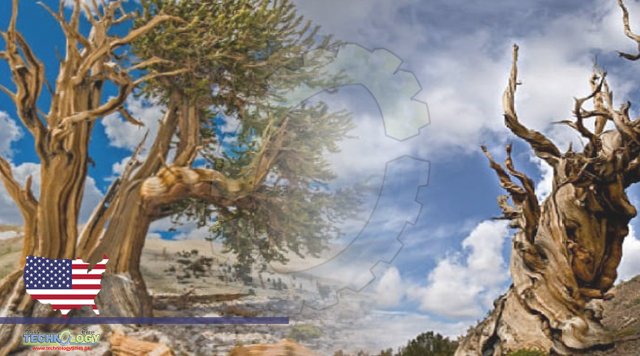In a harsh alpine desert, the Great Basin bristlecone Hardy Pine abide amid climate change. Among them is the oldest tree on Earth (if you can find it). Before the Egyptians built the Pyramids, before Jesus was born, before the Roman Empire formed or collapsed, the trees were here.

Ten thousand feet up in the White Mountains of central California, in a harsh alpine desert where little else survives, groves of gnarled, majestic Great Basin bristlecone pines endure, some for nearly 5,000 years. Their multicolor trunks bend at gravity-defying angles, and their bare branches jut toward the sky, as if plucked from the imaginations of Tim Burton or J.K. Rowling. These ancient organisms, generally considered the oldest trees on Earth, seem to have escaped the stringent laws of nature. “Bristlecones are kind of magical that way,” said Constance Millar, an ecologist who for more than three decades has been studying the Hardy Pine , which grow only in California, Nevada and Utah. Wandering the Ancient Bristlecone Hardy Pine Forest in Inyo County, where these conifers have eked out an existence for millenniums, she said, “gives you that sense of infinity.” I recently drove to Bishop, an outpost in the arid Owens Valley that once served as a backdrop for Westerns (and still could), to visit the hallowed forest nestled in the nearby mountains. My trek felt like something of a pilgrimage, as we Californians revere our trees above almost all else. The Golden State is home to the tallest, largest and oldest trees in the world, what one botany enthusiast called the “tree-fecta.” Hyperion, a 379-foot coastal redwood, stands taller than the Statue of Liberty. General Sherman, the biggest tree on the planet by volume, wows visitors to Sequoia National Park. And here, Methuselah, the king of the hardy bristlecone Hardy Pine is believed to have sprouted 4,855 years ago. These trees, however, face a number of challenges that stem primarily from a changing climate. Severe drought in the West is fueling megafires that have destroyed giant sequoias and redwoods, once thought to be largely fire-resistant. And Dr. Millar recently published research revealing that bark beetles, exploding in population amid warmer temperatures, are, for the first time, killing Great Basin bristlecones. Still, Dr. Millar said she was hopeful about the bristlecones’ survival chances. Bark beetles don’t appear to be harming the bristlecones in the Inyo National Forest, and the insects are native predators, so less threatening than imported pests the trees have not evolved to withstand, she said. Plus, studying the trees’ resilience through eons seems to have granted her some serenity about what the future may hold.
Deep in the Inyo National Forest, along a desolate path accessible only to hikers, twisted trees cling to a rocky slope. This is the Methuselah Grove, where several bristlecones have been confirmed to be over 4,000 years old. Which among them is actually Methuselah is kept secret by the U.S. Forest Service to protect the ancient specimen from vandalism, though visitors try their best to guess. A father and son recently stopped to admire one of the larger bristlecones, with especially long and tangled roots. “This has to be it,” the father declared, scanning the grove for other obvious contenders. Dr. Millar is among the anointed few, mostly researchers and Forest Service employees, who have been entrusted with Methuselah’s exact location. Hardy Pine , The tree “is not particularly remarkable looking,” she said. Others in the know confirmed it is neither the biggest nor the most beautiful. They all pointed out that only select trees have been dated, so it is possible there are even older ones throughout the forest. Jamie Seguerra, a forest ranger, said visitors ask her a few dozen times a day to disclose Methuselah’s location. (Her lips remain sealed.) But most appreciate the effort to keep the tree healthy and safe, she said. Reaching this lonely, tree-studded mountainside involves a half-day drive north from Los Angeles, and a final hour snaking through canyons and climbing thousands of feet until the air becomes noticeably thin. “The people who come here don’t usually stumble upon it,” Ms. Seguerra said, her voice amplified in the quiet of the remote forest. “The majority of people are like, ‘I’ve always wanted to come here and this has been my dream.’” For decades, giant sequoias were believed to be the world’s oldest trees, their size evidence of how long they had been growing. But in 1953, Edmund Schulman, a climate researcher at the University of Arizona, traveled to the Inyo National Forest after hearing that perhaps even more ancient trees were hiding there in plain sight. “Often such rumors had turned out to be unfounded. But not this one!” he wrote in National Geographic in 1958. Dr. Schulman, who had been searching for old trees to understand past droughts, became the first person to find specimens older than 4,000 years, including Methuselah. Scientists determine a tree’s age by extracting a cylindrical sample from its trunk so its rings can be counted. The thickness of those rings, each of which represents a year of the tree’s life, can also reveal information about a region’s annual precipitation levels, temperatures and even volcanic eruptions.
Source: This news is origonally published by nytimes